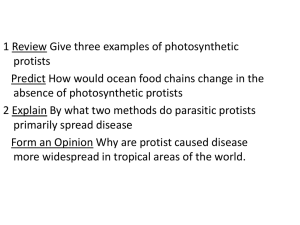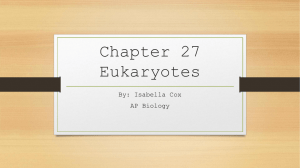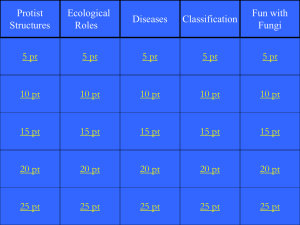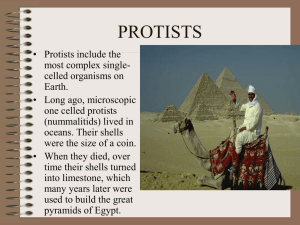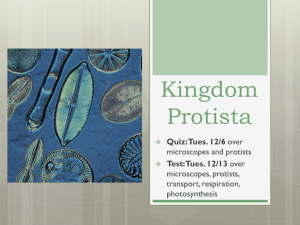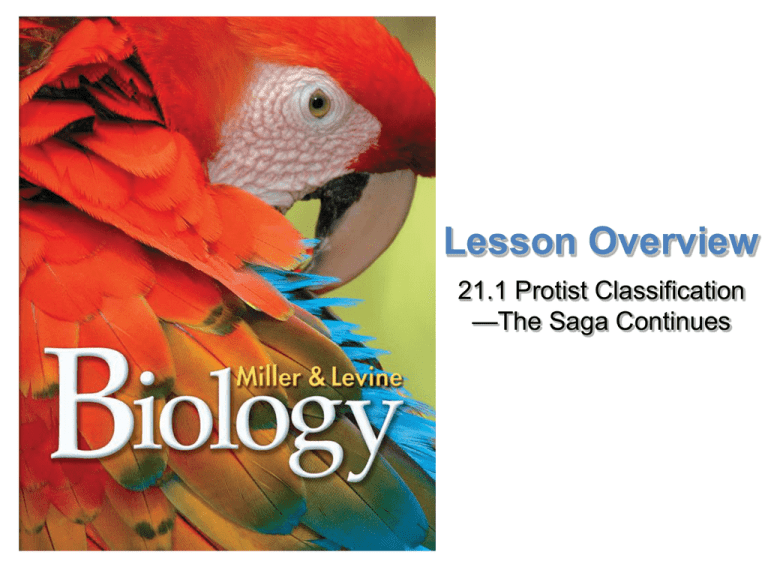
Lesson Overview
Protist Classification—The Saga Continues
Lesson Overview
21.1 Protist Classification
—The Saga Continues
Lesson Overview
Protist Classification—The Saga Continues
The First Eukaryotes
What are protists?
Protists are eukaryotes that are not members of the plant, animal, or fungi
kingdoms.
Lesson Overview
Protist Classification—The Saga Continues
The First Eukaryotes
More than a billion years ago, the first eukaryotes appeared on
Earth.
Single-celled eukaryotes are still with us today and are often called
“protists”—a name that means “first.” Traditionally, protists are
classified as members of the kingdom Protista.
Protists are eukaryotes that are not members of the plant, animal, or
fungi kingdoms.
Lesson Overview
Protist Classification—The Saga Continues
The First Eukaryotes
Although most protists are unicellular, quite a few are not. Brown algae
called kelp are the largest protists. They contain millions of cells arranged
in differentiated tissues.
Kelp are considered protists because they are related more closely to
certain unicellular protists than to members of any other kingdom.
Otters wrap themselves in giant kelp to keep from drifting out to sea while
they sleep.
Lesson Overview
Protist Classification—The Saga Continues
The “Protist” Dilemma
Biologists have discovered that “protists” display a far greater degree of
diversity than any other eukaryotic kingdom.
•
•
•
•
Examples of protists:
Euglena
brown algae
Diatoms
slime molds
Lesson Overview
Protist Classification—The Saga Continues
The “Protist” Dilemma
In addition to their diversity, biologists also found that many “protists”
are far more closely related to members of other eukaryotic kingdoms
than they are to other “protists.”
By definition, the members of a living kingdom should be more like one
another than like members of other kingdoms. This is not true of
protists, which means that reclassification is necessary.
In the past, scientists sorted protists into three groups: plantlike
protists, animal-like protists, and funguslike protists. However, this
solution began to fail as biologists learned that many protists do not fit
into any of these groups.
Biologists also discovered that many of the animal-like and funguslike
protists are so similar that they belong in a single group, not two.
Lesson Overview
Protist Classification—The Saga Continues
Multiple Kingdoms?
The most recent studies of protists divide them into six major clades,
each of which could be considered a kingdom.
Lesson Overview
Protist Classification—The Saga Continues
Multiple Kingdoms?
This cladogram represents an understanding of protist relationships
supported by current research.
Lesson Overview
Protist Classification—The Saga Continues
Multiple Kingdoms?
Surprisingly, the plant, animal, and fungi kingdoms fit right into these six
clades. Animals and fungi actually emerge from the same protist
ancestors.
Protists were the first eukaryotes, and evolution has had far more time
to develop differences among protists than among more recently
evolved eukaryotes like plants and animals.
By finding the fundamental divisions among protists, we also identify the
most basic differences among all eukaryotes.
Lesson Overview
Protist Classification—The Saga Continues
What “Protist” Means Today
Biologists assembling the Tree of Life favor the classification shown in
the cladogram.
Lesson Overview
Protist Classification—The Saga Continues
What “Protist” Means Today
Even though the biologist building the Tree of Life prefer a different
classification, the word “protist” remains in common usage, even among
scientists.
Bear in mind that “protists” are not a single kingdom but a collection of
organisms that includes several distinct clades.
Lesson Overview
Protist Classification—The Saga Continues
Protists—Ancestors and Descendants
How are protists related to other eukaryotes?
Today’s protists include groups whose ancestors were among the very last
to split from the organisms that gave rise to plants, animals, and fungi.
Lesson Overview
Protist Classification—The Saga Continues
Protists—Ancestors and Descendants
Microscopic fossils of eukaryotic cells, like Tappania plana shown,
have been found in rocks as old as 1.5 billion years.
Genetic and fossil evidence indicates that eukaryotes evolved from
prokaryotes and are more closely related to present-day Archaea
than to Bacteria.
The split between Archaea and Eukarya may have come as early
as 2.5 billion years ago. Since that time, protists have diversified
into as many as 300,000 species.
Lesson Overview
Protist Classification—The Saga Continues
Protists—Ancestors and Descendants
Most of the major protist groups have remained unicellular, but two have
produced multicellular organisms. Plants, animals, and fungi arose from
the ancestors of these multicellular groups.
Lesson Overview
Protist Classification—The Saga Continues
Protists—Ancestors and Descendants
The roots of all eukaryotic diversity, from plants to animals, are found
among the ancestors of protists.
Lesson Overview
Protist Classification—The Saga Continues
Lesson Overview
21.2 Protist Structure
and Function
Lesson Overview
Protist Classification—The Saga Continues
How Protists Move
How do protists move in the environment?
Some protists move by changing their cell shape, and some move by
means of specialized organelles. Other protists do not move actively but
are carried by wind, water, or other organisms.
Lesson Overview
Protist Classification—The Saga Continues
Amoeboid Movement
Many unicellular protists move by changing their
shape, a process that makes use of cytoplasmic
projections known as pseudopods. The cytoplasm of
the amoeba, for example, streams into the
pseudopod and the rest of the cell follows.
This type of locomotion is called amoeboid
movement and is found in many protists.
Amoeboid movement is powered by a cytoskeletal
protein called actin. Actin also plays a role in the
muscle contractions of animals.
Lesson Overview
Protist Classification—The Saga Continues
Cilia and Flagella
Many protists move by means of cilia and flagella, structures supported
by microtubules. Cilia are short and numerous, and they move
somewhat like oars on a boat.
Flagella are relatively long and usually number only one or two per cell.
Some flagella spin like tiny propellers, but most produce a wavelike
motion from base to tip.
Lesson Overview
Protist Classification—The Saga Continues
Cilia and Flagella
Protists that move using cilia are known as ciliates, and those that move
with flagella are called flagellates.
Lesson Overview
Protist Classification—The Saga Continues
Passive Movement
Some protists are nonmotile—they depend on air or water currents and
other organisms to carry them around.
These protists form reproductive cells called spores that can enter the
cells of other organisms and live as parasites.
Spore-forming protists include Plasmodium, which is carried by
mosquitoes and causes malaria, and Cryptosporidium, which spreads
through contaminated drinking water and causes severe intestinal
disease.
Lesson Overview
Protist Classification—The Saga Continues
Protist Reproduction
How do protists reproduce?
Some protists reproduce asexually by mitosis.
Others have life cycles that combine asexual
and sexual forms of reproduction.
Lesson Overview
Protist Classification—The Saga Continues
Cell Division
Amoebas, and many other protists, reproduce by mitosis: They
duplicate their genetic material and then divide into two genetically
identical cells.
Mitosis enables protists to reproduce rapidly, especially under ideal
conditions, but it produces cells that are genetically identical to the
parent cell, and thus limits the development of genetic diversity.
Lesson Overview
Protist Classification—The Saga Continues
Conjugation
Paramecia and most ciliates reproduce asexually by mitotic cell division.
However, under stress, paramecia can remake themselves through
conjugation—a process in which two organisms exchange genetic
material.
After conjugating, the cells then reproduce by mitosis.
Lesson Overview
Protist Classification—The Saga Continues
Conjugation
Paramecium has two types of nuclei:
a macronucleus and one or more
smaller micronuclei.
The micronucleus holds a “reserve
copy” of every gene in the cell.
The macronucleus has multiple
copies of the genes the cell uses in
its day-to-day activities.
Lesson Overview
Protist Classification—The Saga Continues
Conjugation
Lesson Overview
Protist Classification—The Saga Continues
Conjugation
Lesson Overview
Protist Classification—The Saga Continues
Conjugation
Lesson Overview
Protist Classification—The Saga Continues
Conjugation
Lesson Overview
Protist Classification—The Saga Continues
Conjugation
Lesson Overview
Protist Classification—The Saga Continues
Conjugation
Lesson Overview
Protist Classification—The Saga Continues
Conjugation
Lesson Overview
Protist Classification—The Saga Continues
Conjugation
Conjugation is not a type of reproduction because no new individuals
are formed.
Conjugation is, however, a sexual process because new combinations
of genetic information are produced.
In a large population, conjugation helps produce and maintain genetic
diversity.
Lesson Overview
The Ecology of Protists
Lesson Overview
21.3 The Ecology of Protists
Lesson Overview
The Ecology of Protists
Autotrophic Protists
What is the ecological significance of photosynthetic protists?
The position of photosynthetic protists at the base of the food chain makes
much of the diversity of aquatic life possible.
Lesson Overview
The Ecology of Protists
Diversity
Organisms commonly called “algae” actually belong to many different
groups. Some (the cyanobacteria) are prokaryotes, some (like green
algae) belong to the plant kingdom, and some are protists.
Photosynthetic protists include many phytoplankton species and the
red and brown algae, as well as euglenas and dinoflagellates.
These organisms share an autotrophic lifestyle, marked by the ability to
use the energy from light to make a carbohydrate food source.
Lesson Overview
The Ecology of Protists
Diversity
Not all photosynthetic protists are closely related to plants.
In fact, the red algae are the most closely related to plants. Many other
photosynthetic protists, however, are more closely related to
nonphotosynthetic protists.
Lesson Overview
The Ecology of Protists
Ecological Roles
Photosynthetic protists play major ecological roles on Earth.
The position of photosynthetic protists at the base of the food chain
makes much of the diversity of aquatic life possible.
Lesson Overview
The Ecology of Protists
Feeding Fish and Whales
Photosynthetic protists make up a large portion of phytoplankton,
the small, free-floating photosynthetic organisms found near the
surface of oceans and lakes.
About half of Earth’s photosynthesis is carried out by phytoplankton.
Lesson Overview
The Ecology of Protists
Feeding Fish and Whales
Phytoplankton provide a direct source of nourishment for organisms as
diverse as shrimp and baleen whales.
Phytoplankton are an indirect source of nourishment for humans.
When you eat tuna fish, you are eating fish that fed on smaller fish that
fed on still smaller animals that fed on photosynthetic protists.
Lesson Overview
The Ecology of Protists
Supporting Coral Reefs
Coral reefs, which are found in warm ocean waters throughout the
world, provide food and shelter to large numbers of fish and other
organisms.
Protist algae known as zooxanthellae provide most of the coral's
energy needs by photosynthesis. By nourishing coral animals,
these algae help maintain the equilibrium of the coral ecosystem.
Coralline red algae also help to provide calcium carbonate to
stabilize growing coral reefs.
Lesson Overview
The Ecology of Protists
Providing Shelter
The largest known protist is giant kelp, a brown alga that can grow to
more than 60 meters in length.
Kelp forests provide shelter for many marine species. Kelp is also a
source of food for sea urchins.
Lesson Overview
The Ecology of Protists
Recycling Wastes
Many protists grow rapidly in regions where sewage is discharged,
where they play a vital role in recycling waste materials.
When the amount of waste is excessive, however, populations of
protists like Euglena can grow to enormous numbers and create an
algal bloom, which can disrupt ecosystem homeostasis.
Lesson Overview
The Ecology of Protists
Recycling Wastes
An algal bloom in a pond or lake can deplete nutrients from the water,
and the decomposition of the dead protists can rob water of its
oxygen, causing fish and invertebrates to die.
Algal blooms of marine protists called dinoflagellates create what is
known as a red tide. The buildup of toxins produced by these protists
can poison fish and shellfish.
Lesson Overview
The Ecology of Protists
Heterotrophic Protists
How do heterotrophic protists obtain food?
Lesson Overview
The Ecology of Protists
Heterotrophic Protists
How do heterotrophic protists obtain food?
Some heterotrophic protists engulf and digest their food, while others live
by absorbing molecules from the environment.
Lesson Overview
The Ecology of Protists
Amoebas
Amoebas can capture and digest their food, surrounding a cell or
particle and then taking it inside themselves to form a food vacuole. A
food vacuole is a small cavity in the cytoplasm that temporarily stores
food.
Once inside the cell, the material is digested and the nutrients are
passed along to the rest of the cell.
Indigestible waste materials remain inside the vacuole until the vacuole
releases them outside the cell.
Lesson Overview
The Ecology of Protists
Ciliates
Paramecium and other ciliates use their cilia to sweep food particles into
the gullet, an indentation in one side of the organism.
The particles are trapped in the gullet and forced into food vacuoles that
form at its base.
Lesson Overview
The Ecology of Protists
Ciliates
The food vacuoles pinch off into the cytoplasm and fuse with lysosomes,
which contain digestive enzymes.
Waste materials are emptied into the environment when the food
vacuole fuses with a region of the cell membrane called the anal pore.
Lesson Overview
The Ecology of Protists
Slime Molds
A slime mold is a heterotrophic protist that thrives on decaying organic
matter.
Slime molds are found in places that are damp and rich in organic
matter—on the floor of a forest or a backyard compost pile, for
example.
Slime molds play key roles in recycling nutrients in an ecosystem.
Lesson Overview
The Ecology of Protists
Slime Molds
At one stage in their life cycle, slime molds exist as a collection of
individual amoebalike cells.
Lesson Overview
The Ecology of Protists
Slime Molds
Eventually these aggregate to form a large structure known as a
plasmodium, which may continue to move.
Lesson Overview
The Ecology of Protists
Slime Molds
The plasmodium eventually develops sporangia, in which meiosis
produces haploid spores to continue the cycle.
Lesson Overview
The Ecology of Protists
Protists That Absorb
Some protists survive by absorbing molecules that other organisms
have released to the environment.
Water molds, for example, grow on dead or decaying plants and
animals, absorbing food molecules through their cellulose cell walls and
cell membranes.
Lesson Overview
The Ecology of Protists
Symbiotic Protists—Mutualists and
Parasites
What types of symbiotic relationships involve protists?
Many protists are involved in mutualistic symbioses, in which they and
their hosts both benefit.
Parasitic protists are responsible for some of the world’s most deadly
diseases, including several kinds of debilitating intestinal diseases, African
sleeping sickness, and malaria.
Lesson Overview
The Ecology of Protists
Symbiotic Protists—Mutualists and
Parasites
Many protists are involved in symbiotic relationships with other organisms.
Symbiosis is a relationship in which two species live closely together.
Many of these symbiotic relationships are mutualistic: Both organisms
benefit.
However, some are parasitic relationships, in which the protist benefits at
the expense of its host.
Lesson Overview
The Ecology of Protists
Mutualists
Many protists are involved in mutualistic symbioses, in which they
and their hosts both benefit.
For example, red algae maintain a mutualistic relationship with the
animals of the coral reef, which could not survive without the
protists’ help.
Lesson Overview
The Ecology of Protists
Mutualists
Trichonympha is another example of a mutualistic protist. Trichonympha
is a flagellated protist that lives within the digestive system of termites
and makes it possible for the insects to digest wood.
Termites themselves do not have enzymes to break down the cellulose
in wood. Trichonympha and other organisms in the termite’s gut
manufacture an enzyme called cellulose that breaks the chemical bonds
in cellulose, making it possible for termites to digest wood.
Lesson Overview
The Ecology of Protists
Parasites and Disease
Parasitic protists are responsible for some of the world’s most
deadly diseases, including several kinds of debilitating intestinal
diseases, African sleeping sickness, and malaria.
Lesson Overview
The Ecology of Protists
Intestinal Diseases
Water-borne protists are found in streams, lakes, and oceans.
Water supplies contaminated by animal or human feces can
spread protist parasites, causing serious and sometimes deadly
outbreaks of intestinal disease.
Lesson Overview
The Ecology of Protists
Intestinal Diseases
For example, the flagellated protist Giardia causes severe diarrhea
and digestive-system problems.
Even crystal-clear streams may be contaminated with Giardia,
which produces tough cysts that can be killed only by boiling water
thoroughly or by adding iodine to the water.
Lesson Overview
The Ecology of Protists
Intestinal Diseases
Entamoeba causes a disease known as amebic dysentery.
The amoebas live in the intestines, where they absorb food from the
host. They also attack the wall of the intestine itself, destroying parts of
it and causing severe bleeding.
Lesson Overview
The Ecology of Protists
Intestinal Diseases
Cryptosporidium is resistant to the chlorine compounds often used to
sanitize drinking water and therefore poses a special threat to public
water systems.
In 2008, an outbreak in Utah sickened more than 2,000 people.
Lesson Overview
The Ecology of Protists
African Sleeping Sickness
The flagellated protists Trypanosoma cause African sleeping sickness.
Trypanosomes are spread from person to person by the bite of the
tsetse fly.
Trypanosomes destroy blood cells and infect other tissues, including
nerve cells. Severe damage to the nervous system causes some
individuals to lose consciousness and lapse into a deep and sometimes
fatal sleep.
Control of the tsetse fly and the protist pathogens that it spreads is a
major goal of health workers in Africa.


